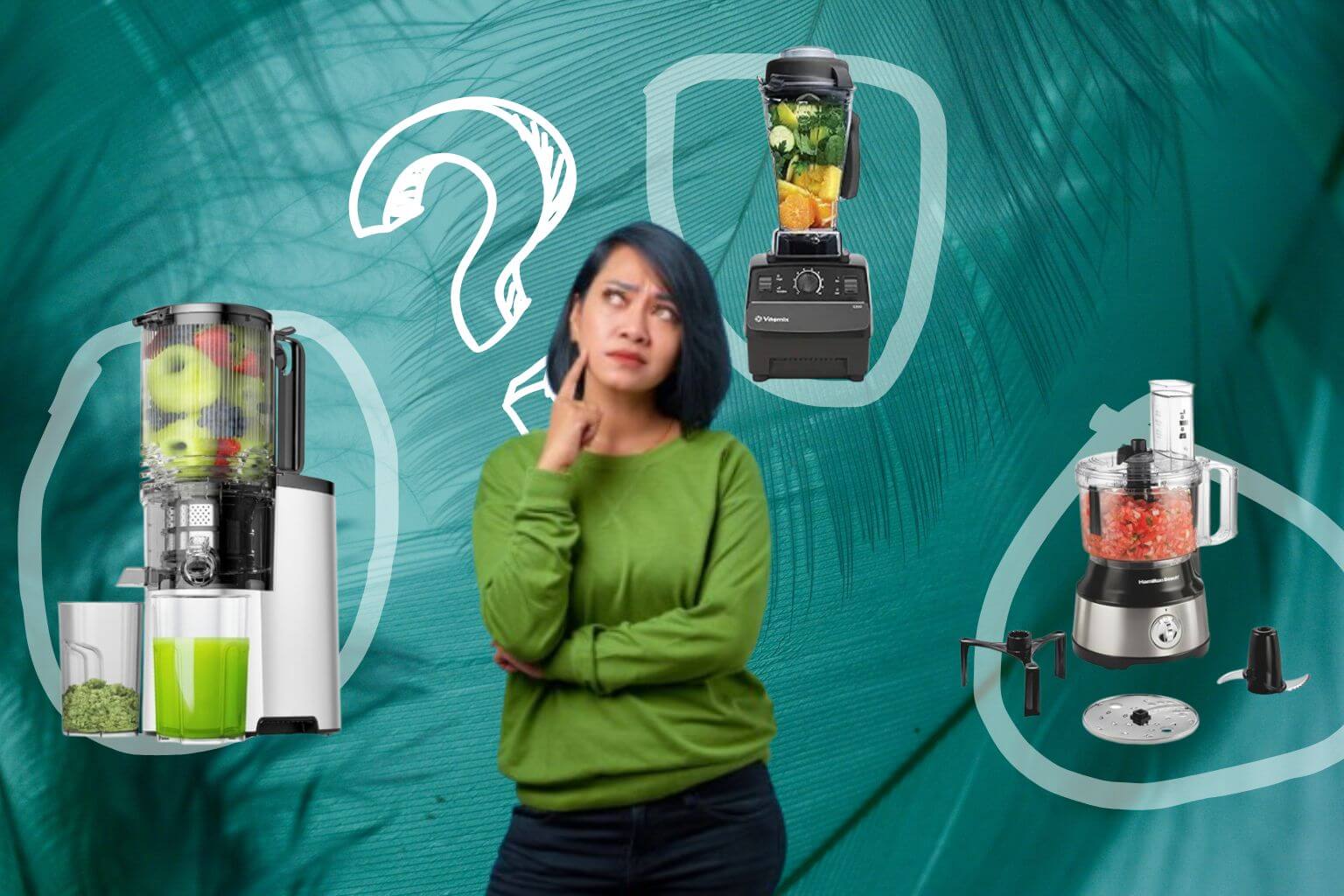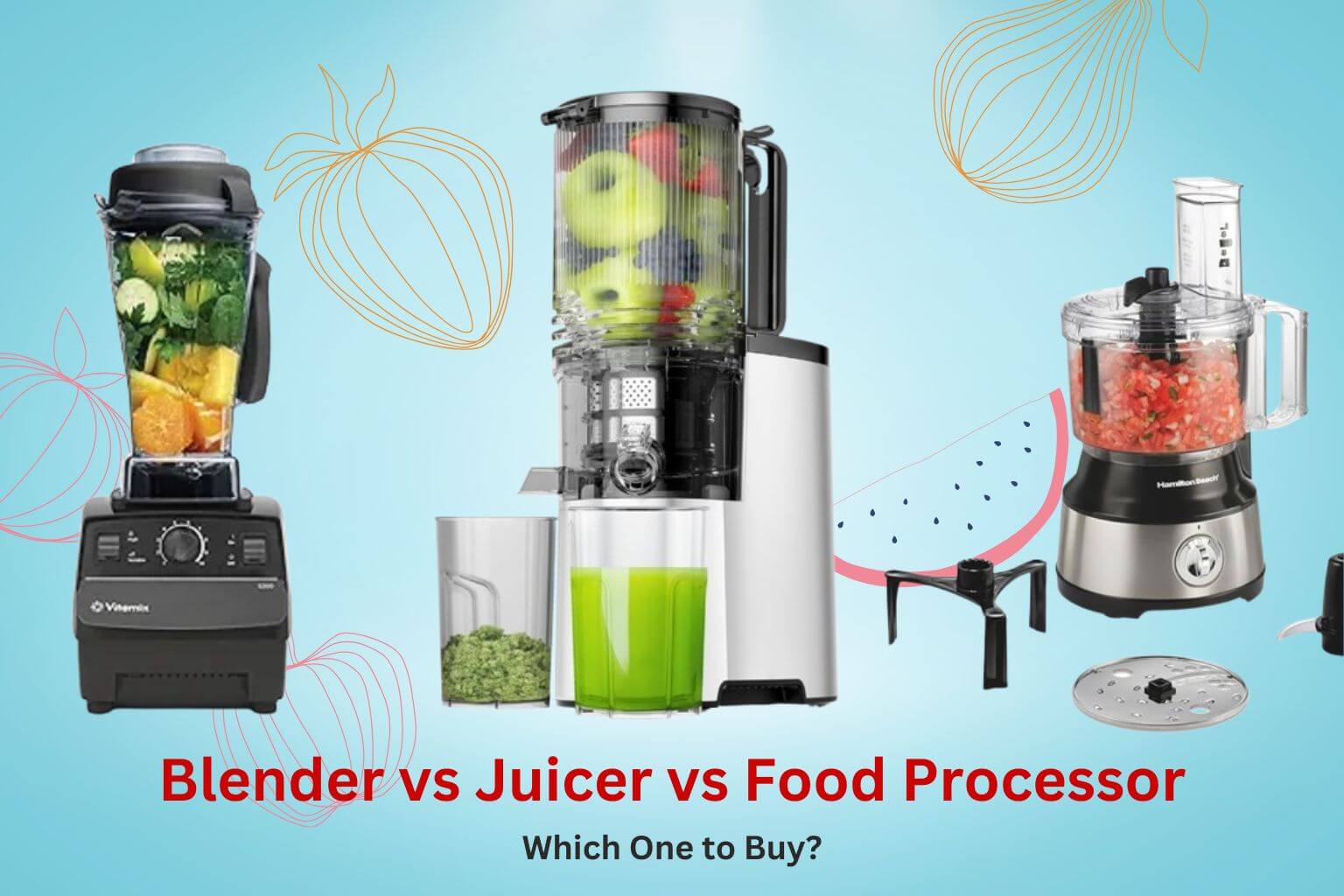Looking for a guide that breaks down the functionalities and differences among juicers, blender and food processors? Look no further, because this is what I'm about to present today in this article.
Well, from the outside all three seem identical, converting your foods from being solid to being sippable. Despite this, it's wise to know that, in reality, they are unique in that they serve different purposes and good at certain trades.
And, that's why understanding when you should use which plays an important role in order to make your time in the kitchen easier.
With that being said, let's move onto the below sections and see how each of them works.

A blender typically consists of a plastic jar with a metal blade at the base. Once the machine is turned on, the jar keeps your content involved with the blade. The moderately sharp blade then rotates in a circular motion and chops yours produces. A powerful electric motor is behind all these activities.
Depending on the various settings, the continuous spiral movement lets air whip into the ingredients. And the speedy action helps them mix rapidly.
Usually, blenders acquire the highest volume capacity among the three and ensure they face less trouble tackling a stash of soup. However, as the content, aka task, gets minuscule, they tend to struggle.
What Are Blenders Good At?
Unlike juicers, blenders are the perfect option when it comes to pureeing water-heavy recipes (such as smoothies). Juicers work by dismantling the fiber with the pulp, an ideal feature of smooth green juices but not so convenient for making dense smoothies. Even worse when it comes to the food processor, it would be drenched if you ever filled the bowl with liquids.
Texturally puree soups are quite common to smoothies, and a handheld immersion blender will be very handy for this. Indeed, it can turn the chunky soup to look smooth without dirtying many dishes during the process. That said, a highly powerful blender like Vitamix 5200 will give you the silkiest outcome.
Additionally, these blenders are gifted with the power to crush ice more easily, helping you to make frozen cocktails. They can also come up with recipes such as nut butter with pleasant cream. When coupled with a mesh strainer attachment, they perform juicing to some extent.
Best Uses for a Blender:
Pros & Cons Of Blenders
Advantages
Constrains
Juicers: The Health Enthusiast’s Favorite
A juicer is designed specifically for extracting juice from fruits and vegetables, separating the pulp and fiber.
Generally, two types of juicers are widely used:
- Centrifugal Juicers: Fast but less efficient in extracting nutrients
- Masticating/Slow Juicers: Slow but retains more nutrients
Centrifugal juicers operate by fine grating and swirling the produce at an incredibly high speed. The spinning basket causes the juices to be separated from the ingredients, hence the name centrifugal.
Masticating juicers, on the other hand, work in a sequence of crushing and then squeezing driven by interlocking levers. The slowness in the process upsets the ingredients cell walls better and extracts juices more easily. The downside, though, is that slow juicers are typically pricier compared to centrifugal variants.
What Are Juicers Good At?
As I mentioned previously, a powerful blender could be an alternative for juicing fruits and veggies with additional attachment. However, a juicer is perfectly suited to the task. They can pull out more nutrients when leaving minimum waste. Additionally, juicers are a better option when dealing with hard elements like carrots or wheatgrass.
These juicers are the safer option to release high yields from thin ingredients (such as leafy greens), whereas a blender's ability is limited in such a situation. Also, according to healthline.com, if you juice your fruit and vegetables instead of blending, you can earn the following benefits:
- More concentrated levels of vitamins, enzymes, and nutrients
- Increased consumption of fruits and vegetables
- Easy absorption of nutrients
So, if you have trouble digesting a fibrous portion, drinking juice will help you increase your daily intake of fruit and vegetables. Note: The 2015-2020 Dietary Guidelines for Americans recommended eating 2 cups (0.47 l) of fruit and 2-1/2 cups of vegetables per day.
If you are looking for a budget-friendly centrifugal juicer, then you may check our reviews on Hamilton Beach Big Mouth Juice Extractor or check Kuvings Whole Slow Juicer B6000S if you are a serious juice lover.
Again, if you do still not buy anyone, you have the option to choose a juicer blender combo that can extract the juice and make smoothies, like Ninja Duo with micro-juice technology.
Best Uses for a Juicer:
Pros & Cons of Juicers
Advantages
Constrains
Food Processors: The Ultimate Kitchen Helper
Food processors usually come with a large surficial bowl and a blade seated deep in it. The integration of this sharp blade along with the less powerful motor almost imitates the motion of a knife that slices food instead of puréeing them with force.
Food processors often come with a range of adjustable disks and blades, mostly for shredding or chopping purposes.
What Are Food Processors Good At?
Food processors provide more accuracy than a blender or a juicer and the right pick for mincing and slicing nuts, fruits, and veggies. You can also use it for thinning chunky blends and mixing dry ingredients.
Apart from being the perfect option for making hummus, pesto, and nut butter, food processors are ideal for a variety of doughs, including pie crust, pizza, and shortbread.
Let alone the grating of firm cheeses or preparing breadcrumbs. When configured with a slicing or shredding disk, it can slice and shred respectively at the same time.
Best Uses for a Food Processor:
Pros & Cons of Food Processor
Advantages
Constrains
Which One Should You Buy or Use?
Well, if you have the budget only to buy a single device, find what you're most likely to cook at first. I suggest going for a professional-grade blender in this instance, due to its superior versatility among the three.
Even though it's not an exact science, a powerful blender has the option to make juicers when combined with a mesh strainer. It can even carry out some functions best reserved for the food processors, including nut butter, pesto, condensed purées, etc.
With that being said, you could be different, maybe a juicing aficionado or desperate to cut the time shredding and slicing. In such a case, you should listen to your needs and invest your money accordingly.
So, the general principle when choosing the best between them is:
- If you love smoothies and soups, get a blender.
- If you want fresh juices, go for a juicer.
- If you require help with meal prep, choose a food processor.

Blender Food Processor Combo
If you are in confusion between blender and food processor, you have another option to choose from, and that is a blender food processor combo. Some blender brands on the market come with food processing accessories to allow you to have nutritious smoothies and get your food processed to cook without having two different appliances.
So, with a blender food processor combination, you can do several jobs like —
- Make smoothies or shakes of fruit and vegetables that are liquid-dense
- Mincing or cutting fruit, vegetables, or nuts for cooking, making dough, or other savory cocktails.
So, a good blender cum food processor would not only help you save hard-earned money but also save your time and room on the countertop. Want to learn more about this type? Then go through healthyappliance.com to learn unknown facts about the blender food processor combo, as they have figured out the best resources across the web.
So, that's it for today!
I hope you're able to nail down the puzzle in the juicer vs blender vs food processor debate and found the required information here.
FAQs: Blender vs Juicer vs Food Processor Debate
1. Can I use a blender as a food processor?
A blender can handle some food processing tasks like pureeing and blending, but it lacks the precision for chopping, shredding, and slicing.
2. Is a juicer better than a blender for making smoothies?
No, a juicer removes fiber, while a blender retains all parts of the fruit or vegetable, making it ideal for smoothies.
3. Can a food processor make juices?
A food processor can extract some liquid from fruits and vegetables, but it does not separate the pulp like a juicer.
4. Which appliance is best for making nut butter?
A high-powered blender or a food processor works best for making nut butter, as they can grind nuts into a smooth consistency.
5. What is the easiest appliance to clean?
Blenders are typically the easiest to clean, especially if they have a self-cleaning function. Juicers and food processors have more parts that require thorough cleaning.
Final Verdict
If you have the budget and space, owning all three appliances can make your kitchen highly efficient. However, if you need to pick just one, base your decision on what you plan to make most often.
Got questions? Drop them in the comments below! Happy blending, juicing, and processing! 😊

